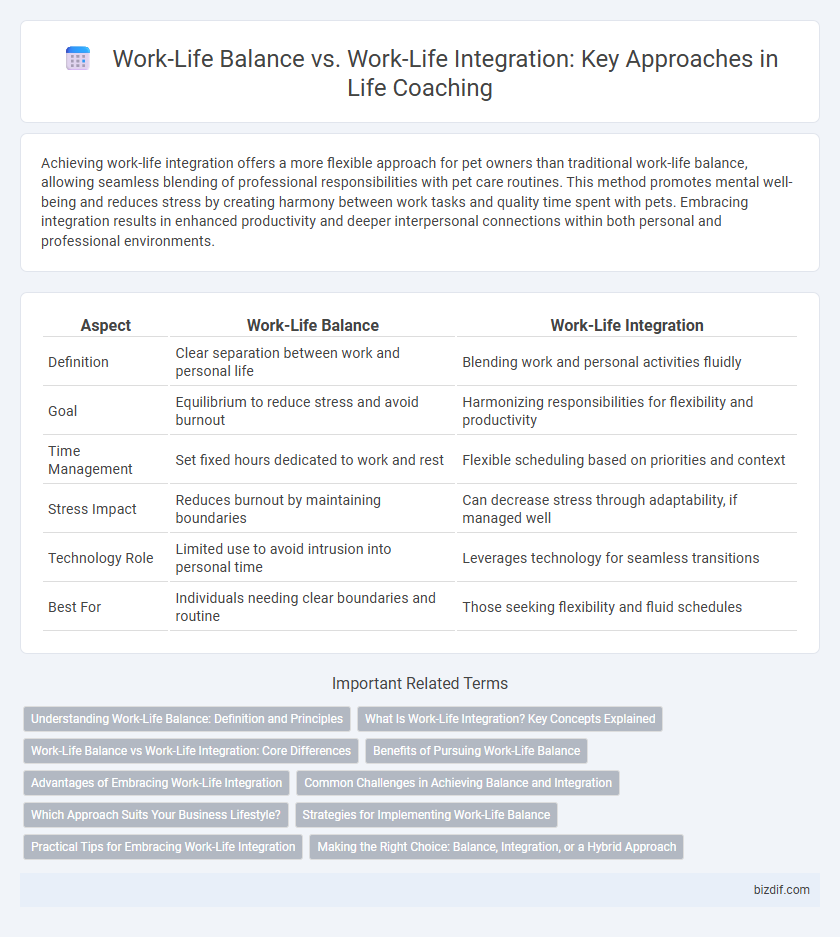Achieving work-life integration offers a more flexible approach for pet owners than traditional work-life balance, allowing seamless blending of professional responsibilities with pet care routines. This method promotes mental well-being and reduces stress by creating harmony between work tasks and quality time spent with pets. Embracing integration results in enhanced productivity and deeper interpersonal connections within both personal and professional environments.
Table of Comparison
| Aspect | Work-Life Balance | Work-Life Integration |
|---|---|---|
| Definition | Clear separation between work and personal life | Blending work and personal activities fluidly |
| Goal | Equilibrium to reduce stress and avoid burnout | Harmonizing responsibilities for flexibility and productivity |
| Time Management | Set fixed hours dedicated to work and rest | Flexible scheduling based on priorities and context |
| Stress Impact | Reduces burnout by maintaining boundaries | Can decrease stress through adaptability, if managed well |
| Technology Role | Limited use to avoid intrusion into personal time | Leverages technology for seamless transitions |
| Best For | Individuals needing clear boundaries and routine | Those seeking flexibility and fluid schedules |
Understanding Work-Life Balance: Definition and Principles
Work-life balance involves maintaining clear boundaries between professional responsibilities and personal life to reduce stress and improve well-being. It emphasizes time management and prioritization to ensure adequate attention to both career and personal interests. Principles include setting limits, scheduling downtime, and fostering mindfulness to create harmony between work demands and life satisfaction.
What Is Work-Life Integration? Key Concepts Explained
Work-life integration involves blending professional responsibilities and personal activities to create a harmonious lifestyle that reduces stress and increases overall satisfaction. Unlike traditional work-life balance, which aims to separate work from personal life, integration focuses on flexibility, allowing tasks and roles to coexist seamlessly throughout the day. Key concepts include prioritizing tasks based on real-time needs, utilizing technology for remote work, and fostering a mindset that adapts to the fluid boundaries between work and home.
Work-Life Balance vs Work-Life Integration: Core Differences
Work-life balance emphasizes clear boundaries between professional and personal time, aiming to allocate specific hours for work and leisure to prevent burnout. Work-life integration blends work and personal responsibilities fluidly, leveraging technology and flexible schedules to allow simultaneous management of both domains. The core difference lies in balance seeking separation and integration promoting harmony through flexibility and overlap of work-personal activities.
Benefits of Pursuing Work-Life Balance
Pursuing work-life balance enhances mental well-being by reducing stress and preventing burnout through clear boundaries between professional and personal time. It increases productivity and job satisfaction by allowing individuals to recharge and maintain focus during work hours. Achieving this balance supports healthier relationships and overall life satisfaction by ensuring dedicated time for family, hobbies, and self-care.
Advantages of Embracing Work-Life Integration
Embracing work-life integration enhances productivity by allowing seamless transitions between professional and personal responsibilities, reducing stress and burnout. This approach fosters greater flexibility, enabling individuals to tailor their schedules to maximize energy and focus throughout the day. Work-life integration also promotes holistic well-being, as it encourages alignment of career goals with personal values and priorities.
Common Challenges in Achieving Balance and Integration
Common challenges in achieving work-life balance and integration include managing time effectively to meet professional and personal demands, coping with constant connectivity through digital devices, and setting clear boundaries to prevent burnout. Many individuals struggle with prioritizing tasks amid overlapping responsibilities, leading to stress and reduced productivity. Emotional exhaustion and difficulty in disconnecting from work are significant barriers that life coaching aims to address for sustainable well-being.
Which Approach Suits Your Business Lifestyle?
Work-life balance emphasizes clear boundaries between professional and personal time, ideal for businesses with fixed schedules and predictable workloads, promoting employee well-being and reducing burnout. Work-life integration blends tasks across life domains, benefiting entrepreneurs and remote workers seeking flexibility and continuous productivity throughout the day. Choosing the right approach depends on your business lifestyle, industry demands, and personal priorities to maximize efficiency and satisfaction.
Strategies for Implementing Work-Life Balance
Effective strategies for implementing work-life balance include setting clear boundaries between work and personal time, prioritizing tasks to enhance productivity, and scheduling regular breaks to prevent burnout. Utilizing time management tools and embracing flexible work arrangements promote sustained focus and reduce stress. Encouraging open communication with employers about workload expectations further supports a harmonious balance between professional responsibilities and personal well-being.
Practical Tips for Embracing Work-Life Integration
Embracing work-life integration entails blending professional and personal responsibilities seamlessly to enhance overall well-being and productivity. Prioritize setting clear boundaries, such as dedicated work hours and personal time, while leveraging technology to create flexible schedules that accommodate both career objectives and family needs. Incorporate regular mindfulness practices and proactive communication with employers and family members to sustain a harmonious balance between work and life commitments.
Making the Right Choice: Balance, Integration, or a Hybrid Approach
Choosing between work-life balance and work-life integration depends on individual needs and professional demands, with work-life balance emphasizing clear boundaries and work-life integration blending personal and professional activities. Life coaching helps clients assess priorities, stress levels, and lifestyle preferences to tailor strategies promoting productivity and well-being. A hybrid approach combines structured time management with flexible routines to optimize fulfillment in both career and personal life.
Work-life balance vs Work-life integration Infographic

 bizdif.com
bizdif.com